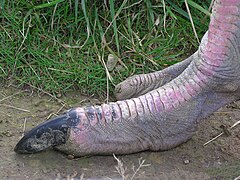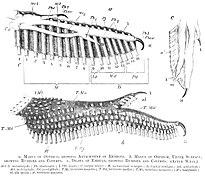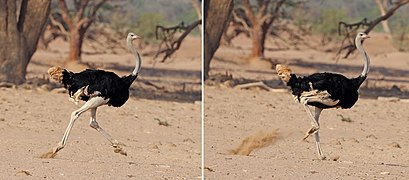Common ostrich
| Common ostrich | |||||
|---|---|---|---|---|---|

| |||||
| South African (S. c. australis) male (left) and females | |||||
| Scientific classification | |||||
| Domain: | Eukaryota | ||||
| Kingdom: | Animalia | ||||
| Phylum: | Chordata | ||||
| Class: | Aves | ||||
| Infraclass: | Palaeognathae | ||||
| Order: | Struthioniformes | ||||
| Family: | Struthionidae | ||||
| Genus: | Struthio | ||||
| Species: | S. camelus
| ||||
| Binomial name | |||||
| Struthio camelus | |||||
| Subspecies[3] | |||||
| |||||
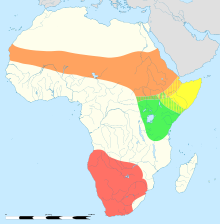
| |||||
Struthio distribution map
| |||||
The common ostrich (Struthio camelus), or simply ostrich, is a
The common ostrich belongs to the
The common ostrich's diet consists mainly of plant matter, though it also eats invertebrates and small reptiles. It lives in nomadic groups of 5 to 50 birds. When threatened, the ostrich will either hide itself by lying flat against the ground or run away. If cornered, it can attack with a kick of its powerful legs. Mating patterns differ by geographical region, but territorial males fight for a harem of two to seven females.
The common ostrich is
Description
The common ostrich is the largest and heaviest living bird. Males stand 2.1 to 2.75 m (6 ft 11 in to 9 ft 0 in) tall and weigh 100 to 130 kilograms (220–290 lb), whereas females are about 1.75 to 1.9 m (5 ft 9 in to 6 ft 3 in) tall and weigh 90 to 120 kilograms (200–260 lb).[14] While exceptional male ostriches (in the nominate subspecies) can weigh up to 156.8 kg (346 lb), some specimens in South Africa can only weigh between 59.5 to 81.3 kilograms (131–179 lb).[15] New chicks are fawn in color, with dark brown spots.[16] After three months they start to gain their juvenile plumage, which is steadily replaced by adult-like plumage during their second year. At four or five months old, they are already about half the size of an adult bird, and after a year they reach adult height, but not till they are 18 months old will they be fully as heavy as their parents.[14]
The feathers of adult males are mostly black, with white
-
Head feathers are a thin layer of down.
-
Long eyelashes protect the eyes.
-
Feet are frequently missing the nail on the outer toe.
-
Skull
-
Claws on the wings
-
Male running, Namibia
The long neck and legs keep their head up to 2.8 m (9 ft 2 in) above the ground, and their eyes are said to be the largest of any land vertebrate – 50 mm (2 in) in diameter[18] – helping them to see predators at a great distance. The eyes are shaded from sunlight from above.[19][20] However, the head and bill are relatively small for the birds' huge size, with the bill measuring 12 to 14.3 cm (4+3⁄4 to 5+3⁄4 in).[10]
Their skin varies in color depending on the subspecies, with some having light or dark gray skin and others having pinkish or even reddish skin. The strong legs of the common ostrich are unfeathered and show bare skin, with the
The feathers lack the tiny hooks that lock together the smooth external feathers of flying birds, and so are soft and fluffy and serve as insulation. Common ostriches can tolerate a wide range of temperatures. In much of their habitat, temperatures vary as much as 40 °C (70 °F) between night and day. Their temperature control relies in part on behavioral thermoregulation. For example, they use their wings to cover the naked skin of the upper legs and flanks to conserve heat, or leave these areas bare to release heat. The wings also function as stabilizers to give better maneuverability when running. Tests have shown that the wings are actively involved in rapid braking, turning, and zigzag maneuvers.
The common ostrich's
Taxonomy
The common ostrich was originally described by Carl Linnaeus from Sweden in his 18th-century work, Systema Naturae under its current binomial name.[28] Its genus is derived from the Late Latin struthio meaning "ostrich". The specific name is an allusion to "strouthokamelos" the Ancient Greek name for the ostrich, meaning camel-sparrow,[29] the "camel" term referring to its dry habitat.[30] Στρουθοκάμηλος is still the modern Greek name for the ostrich.
The common ostrich belongs to the Infraclass Palaeognathae commonly known as
Subspecies
Four subspecies are recognized:
| Subspecies | Description | Image |
|---|---|---|
| North African ostrich (S. c. camelus), also known as the red-necked ostrich or Barbary ostrich | Lives in North Africa. Historically it was the most widespread subspecies, ranging from Ethiopia and Sudan in the east throughout the Sahel[31] to Senegal and Mauritania in the west, and north to Egypt and southern Morocco, respectively. It has now disappeared from large parts of this range,[32] and it only remains in six of the 18 countries where it originally occurred, leading some to consider it Critically Endangered.[33] It is the largest subspecies, at 2.74 m (9 ft 0 in) in height and up to 154 kilograms (340 lb) in weight.[34] The neck is pinkish-red, the plumage of males is black and white, and the plumage of females is grey.[34]
|
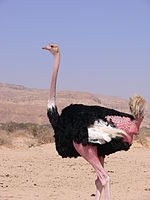
|
| South African ostrich (S. c. australis), also known as the black-necked ostrich, Cape ostrich, or southern ostrich | Found south of the Little Karoo area of Cape Province.[35]
|
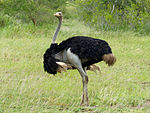
|
| Masai ostrich (S. c. massaicus), also known as the pink-necked ostrich or East African ostrich | It has some small feathers on its head, and its neck and thighs are pink. During the | 
|
| Arabian ostrich (†S. c. syriacus), also known as the Syrian ostrich or Middle Eastern ostrich | Was formerly very common in the Arabian Peninsula, Syria,[31] Iraq, and Israeli Negev;[36] it became extinct around 1966.
|
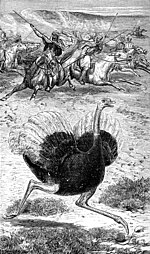
|
| Species | Description | Image |
|---|---|---|
| Somali ostrich (S. molybdophanes), also known as the blue-necked ostrich | Found in southern Ethiopia, northeastern Kenya, and Somalia.[31] The neck and thighs are grey-blue, and during the mating season, the male's neck and thighs become brighter and bluer. The females are more brown than those of other subspecies.[34] It generally lives in pairs or alone, rather than in flocks. Its range overlaps with S. c. massaicus in northeastern Kenya.[34] | 
|
Some analyses indicate that the Somali ostrich is now considered a full species; the
The population from Río de Oro was once separated as Struthio camelus spatzi because its eggshell pores were shaped like a teardrop and not round. As there is considerable variation of this character and there were no other differences between these birds and adjacent populations of S. c. camelus, the separation is no longer considered valid.[39][40] However, a study analysing the postcranial skeleton of all living and recently extinct species and subspecies of ostriches appeared to validate S. c. spatzi based on its unique skeletal proportions.[41] This population disappeared in the latter half of the 20th century. There were 19th-century reports of the existence of small ostriches in North Africa; these are referred to as Levaillant's ostrich (Struthio bidactylus) but remain a hypothetical form not supported by material evidence.[42]
Distribution and habitat
Common ostriches formerly occupied Africa north and south of the
Research conducted by the
Ostriches are farmed in Australia. Many escaped, however, and feral ostriches now roam the
Behaviour and ecology

Common ostriches normally spend the winter months in pairs or alone. Only 16 percent of common ostrich sightings were of more than two birds.[10] During breeding season and sometimes during extreme rainless periods ostriches live in nomadic groups of five to 100 birds (led by a top hen) that often travel together with other grazing animals, such as zebras or antelopes.[43] Ostriches are diurnal, but may be active on moonlit nights. They are most active early and late in the day.[10] The male common ostrich territory is between two and twenty square kilometres (3⁄4 and 7+3⁄4 sq mi).[16]

With their acute eyesight and hearing, common ostriches can sense predators such as lions from far away. When being pursued by a predator, they have been known to reach speeds in excess of 70 km/h (40 mph),[10] or possibly 80 km/h (50 mph)[49] and can maintain a steady speed of 50 km/h (30 mph), which makes the common ostrich the world's fastest two-legged animal.[50][51] When lying down and hiding from predators, the birds lay their heads and necks flat on the ground, making them appear like a mound of earth from a distance, aided by the heat haze in their hot, dry habitat.[52][53]
When threatened, common ostriches run away, but they can cause serious injury and death with kicks from their powerful legs.[43] Their legs can only kick forward.[54] The kick from an ostrich can yield 225 kgf.[55]
Feeding
They mainly feed on seeds, shrubs, grass, fruit, and flowers;
Mating


Common ostriches become
The cock performs with his wings, alternating wing beats, until he attracts a mate. They will go to the mating area and he will maintain privacy by driving away all intruders. They graze until their behavior is synchronized, then the feeding becomes secondary and the process takes on a ritualistic appearance. The cock will then excitedly flap alternate wings again and start poking on the ground with his bill. He will then violently flap his wings to symbolically clear out a nest in the soil. Then, while the hen runs a circle around him with lowered wings, he will wind his head in a spiral motion. She will drop to the ground and he will mount for copulation.[10] Common ostriches raised entirely by humans may direct their courtship behavior not at other ostriches, but toward their human keepers.[59]
-
Only 15% of the surviving chicks reach 1 year of age.
-
Chick
-
Recently hatched from egg
-
Hen with chicks
-
Female incubating eggs
-
Nest


The female common ostrich lays her fertilized
The eggs are incubated by the females by day and by the males by night. This uses the coloration of the two sexes to escape detection of the nest. The drab female blends in with the sand, while the black male is nearly undetectable in the night.
Predators

As a flightless species in the rich biozone of the African savanna, the common ostrich faces a variety of formidable predators throughout its life cycle. Animals that prey on ostriches of all ages may include
Due to predation pressure, common ostriches have many antipredator tactics. Though they can deliver formidable kicks, they use their great eyesight and speed to run from most of their predators.[67] Since ostriches that have detected predators are almost impossible to catch, most predators will try to ambush an unsuspecting bird using obstructing vegetation or other objects.[58] Some ostriches forage with other ostriches or mammals such as wildebeests and zebras to detect predators more efficiently.[68][34] If the nest or young are threatened, either or both of the parents may create a distraction, feigning injury.[63] However, they may sometimes fiercely fight predators, especially when chicks are being defended, and are capable of killing humans, hyenas, and even lions in such confrontations.[51][69][70][71]
Usually, ostrich hunting is done by male cheetah coalitions in the Kalahari region during the night, when ostrich's vigilance is less effective.[72] Cheetahs in other regions rarely hunt ostriches, but an exceptional coalition composed of three East African cheetahs has been reported in Kenya.[73][74] Similarly, lions hunt ostriches mainly in the Kalahari region and not in other regions, or take ostriches as only a small percentage of their prey.[73] Overall, due to their speed, vigilance, and possibly dangerous kick, ostriches are usually avoided by most predators, including lions, leopards, wild dogs, and cheetahs.[75][76][77][78] Despite parental care, 90% is typical for chick mortality, most of it caused by predation.[71]
Physiology
Respiration
Anatomy

Morphology of the common ostrich

The largest air sacs found within the respiratory system are those of the post-thoracic region, while the others decrease in size respectively, the interclavicular (unpaired), abdominal, pre-thoracic, and lateral clavicular sacs.[81] The adult common ostrich lung lacks connective tissue known as interparabronchial septa, which render strength to the non-compliant avian lung in other bird species. Due to this the lack of connective tissue surrounding the parabronchi and adjacent parabronchial lumen, they exchange blood capillaries or avascular epithelial plates.[79] Like mammals, ostrich lungs contain an abundance of type II cells at gas exchange sites; an adaptation for preventing lung collapse during slight volume changes.[79]
Function
The common ostrich is an endotherm and maintains a body temperature of 38.1–39.7 °C (100.6–103.5 °F) in its extreme living temperature conditions, such as the heat of the savanna and desert regions of Africa.[82] The ostrich utilizes its respiratory system via a costal pump for ventilation rather than a diaphragmatic pump as seen in most mammals.[80] Thus, they are able to use a series of air sacs connected to the lungs. The use of air sacs forms the basis for the three main avian respiratory characteristics:
- Air is able to flow continuously in one direction through the lung, making it more efficient than the mammalian lung.
- It provides birds with a large residual volume, allowing them to breathe much more slowly and deeply than a mammal of the same body mass.
- It provides a large source of air that is used not only for gaseous exchange, but also for the transfer of heat by evaporation.[80]

Inhalation begins at the mouth and the nostrils located at the front of the beak. The air then flows through the anatomical dead space of a highly vascular trachea (c. 78 cm or 30+1⁄2 in) and expansive bronchial system, where it is further conducted to the posterior air sacs.
To compensate for the large "dead" space, the common ostrich trachea lacks valves to allow faster inspiratory air flow.[84] In addition, the total lung capacity of the respiratory system, (including the lungs and ten air sacs) of a 100 kg (220 lb) ostrich is about 15 L (920 cu in), with a tidal volume ranging from 1.2–1.5 L (75–90 cu in).[81][84] The tidal volume is seen to double resulting in a 16-fold increase in ventilation.[80] Overall, ostrich respiration can be thought of as a high velocity-low pressure system.[81] At rest, there is a small pressure difference between the ostrich air sacs and the atmosphere, suggesting simultaneous filling and emptying of the air sacs.[84]
The increase in respiration rate from the low range to the high range is sudden and occurs in response to
Common ostriches develop via
Circulation
Heart anatomy
The common ostrich heart is a closed system, contractile chamber. It is composed of
The common ostrich's heart has similar features to other avian species, like having a
- The right atrioventricular valve is fixed to the interventricular septum, by a thick muscular stock, which prevents back-flow of blood into the atrium when ventricular systole is occurring.[87] In the fowl this valve is only connected by a short septal attachment.[87]
- Pulmonary veins attach to the left atrium separately, and also the opening to the pulmonary veins are separated by a septum.[87]
- Moderator bands, full of Purkinje fibers, are found in different locations in the left and right ventricles.[87] These bands are associated with contractions of the heart and suggests this difference causes the left ventricle to contract harder to create more pressure for a completed circulation of blood around the body.[87]
The
The
These
Blood composition
The
During the embryonic stage, Hemoglobin E is present.[92] This subtype increases oxygen affinity in order to transport oxygen across the allantoic membrane of the embryo.[92] This can be attributed to the high metabolic need of the developing embryo, thus high oxygen affinity serves to satisfy this demand. When the chick hatches hemoglobin E diminishes while hemoglobin A and D increase in concentration.[92] This shift in hemoglobin concentration results in both decreased oxygen affinity and increased P50 value.[92]
Furthermore, the P50 value is influenced by differing organic modulators.[92] In the typical mammalian RBC 2,3 – DPG causes a lower affinity for oxygen. 2,3- DPG constitutes approximately 42–47%, of the cells phosphate of the embryonic ostrich.[92] However, the adult ostrich have no traceable 2,3- DPG.In place of 2,3-DPG the ostrich uses inositol polyphosphates (IPP), which vary from 1–6 phosphates per molecule.[92] In relation to the IPP, the ostrich also uses ATP to lower oxygen affinity.[92] ATP has a consistent concentration of phosphate in the cell[92] – around 31% at incubation periods and dropping to 16–20% in 36-day-old chicks.[92] However, IPP has low concentrations, around 4%, of total phosphate concentration in embryonic stages, but the IPP concentration jumps to 60% of total phosphate of the cell.[92] The majority of phosphate concentration switches from 2,3- DPG to IPP, suggesting the result of the overall low oxygen affinity is due to these varying polyphosphates.[92]
Concerning immunological adaptation, it was discovered that wild common ostriches have a pronounced non-specific immunity defense, with blood content reflecting high values of
Osmoregulation
Physiological challenges
The common ostrich is a
System overview
The common ostrich is well-adapted to hot, arid environments through specialization of
Common ostriches have two
Kidney function
Common ostrich kidneys are fairly large and so are able to hold significant amounts of
In mammals and common ostriches, the increase of the
Water intake and turnover
Common ostriches employ adaptive features to manage the dry heat and
Water mass accounts for 68% of body mass in adult common ostriches; this is down from 84% water mass in 35-day-old chicks. The differing degrees of water retention are thought to be a result of varying body fat mass.[80] In comparison to smaller birds ostriches have a lower evaporative water loss resulting from their small body surface area per unit weight.[83]
When heat stress is at its maximum, common ostriches are able to recover evaporative loss by using a metabolic water mechanism to counter the loss by urine, feces, and respiratory evaporation. An experiment to determine the primary source of water intake in the ostrich indicated that while the ostrich does employ a metabolic water production mechanism as a source of hydration, the most important source of water is food. When ostriches were restricted to the no food or water condition, the metabolic water production was only 0.5 L·d−1, while total water lost to urine, feces, and evaporation was 2.3 L·d−1. When the birds were given both water and food, total water gain was 8.5 L·d−1. In the food only condition total water gain was 10.1 L·d−1. These results show that the metabolic water mechanism is not able to sustain water loss independently and that food intake, specifically of plants with a high water content such as Euphorbia heterochroma, is necessary to overcome water loss challenges in the common ostrich's arid habitat.[80]
In times of water deprivation, urine
Nasal glands
A number of avian species use nasal salt glands, alongside their kidneys, to control hypertonicity in their blood plasma.[97] However, the common ostrich shows no nasal glandular function in regard to this homeostatic process.[97] Even in a state of dehydration, which increases the osmolality of the blood, nasal salt glands show no sizeable contribution of salt elimination.[97] Also, the overall mass of the glands was less than that of the duck's nasal gland.[97] The common ostrich, having a heavier body weight, should have larger, heavier nasal glands to more effectively excrete salt from a larger volume of blood, but this is not the case. These unequal proportions contribute to the assumption that the common ostrich's nasal glands do not play any role in salt excretion.
Biochemistry
The majority of the common ostrich's internal solutes are made up of sodium ions (Na+), potassium ions (K+), chloride ions (Cl−), total short-chain fatty acids (SCFA), and acetate.[93] The caecum contains a high water concentration with reduced levels nearing the terminal colon and exhibits a rapid fall in Na+ concentrations and small changes in K+ and Cl−.[93] The colon is divided into three sections and takes part in solute absorption. The upper colon largely absorbs Na+ and SCFA and partially absorbs KCl.[93] The middle colon absorbs Na+ and SCFA, with little net transfer of K+ and Cl−.[93] The lower colon then slightly absorbs Na+ and water and secretes K+. There is no net movements of Cl− and SCFA found in the lower colon.[93]
When the common ostrich is in a dehydrated state, plasma osmolality, Na+, K+, and Cl− ions all increase; however, K+ ions return to controlled concentration.
Ostriches are
Thermoregulation
Common ostriches are homeothermic endotherms; they regulate a constant body temperature via regulating their metabolic heat rate.[83] They closely regulate their core body temperature, but their appendages may be cooler in comparison as found with regulating species.[83] The temperature of their beak, neck surfaces, lower legs, feet, and toes are regulated through heat exchange with the environment.[99] Up to 40% of their produced metabolic heat is dissipated across these structures, which account for about 12% of their total surface area.[99] Total evaporative water loss (TEWL) is statistically lower in the common ostrich than in membering ratites.[100]
As ambient temperature increases, dry heat loss decreases, but evaporative heat loss increases because of increased respiration.[99] As ostriches experience high ambient temperatures, circa 50 °C (120 °F), they become slightly hyperthermic; however, they can maintain a stable body temperature, around 40 °C (105 °F), for up to 8 hours in these conditions.[81] When dehydrated, the common ostrich minimizes water loss, causing the body temperature to increase further.[81] When the body heat is allowed to increase the temperature gradient between the common ostrich and ambient heat is equilibrated.[83]
Physical adaptations
Common ostriches have developed a comprehensive set of behavioral adaptations for thermoregulation, such as altering their feathers.[80] Common ostriches display a feather fluffing behavior that aids them in thermoregulation by regulating convective heat loss at high ambient temperatures.[99] They may also physically seek out shade in times of high ambient temperatures. When feather fluffing, they contract their muscles to raise their feathers to increase the air space next to their skin.[83] This air space provides an insulating thickness of 7 cm (3 in).[101] The ostrich will also expose the thermal windows of their unfeathered skin to enhance convective and radiative loss in times of heat stress.[100] At higher ambient temperatures lower appendage temperature increases to 5 °C (9.0 °F) difference from ambient temperature.[99] Neck surfaces are around 6–7 °C (11–13 °F) difference at most ambient temperatures, except when temperatures are around 25 °C (77 °F) it was only 4 °C (7 °F) above ambient.[99]
At low ambient temperatures the common ostrich utilizes feather flattening, which conserves body heat through insulation. The low
Internal adaptations
The use of countercurrent heat exchange with blood flow allows for regulated conservation/ elimination of heat of appendages.[83] When ambient temperatures are low, heterotherms will constrict their arterioles to reduce heat loss along skin surfaces.[83] The reverse occurs at high ambient temperatures, arterioles dilate to increase heat loss.[83]
At ambient temperatures below their body temperatures (thermal neutral zone (TNZ)), common ostriches decrease body surface temperatures so that heat loss occurs only across about 10% of total surface area.[99] This 10% include critical areas that require blood flow to remain high to prevent freezing, such as their eyes.[99] Their eyes and ears tend to be the warmest regions.[99] It has been found that temperatures of lower appendages were no more than 2.5 °C (4.5 °F) above ambient temperature, which minimizes heat exchange between feet, toes, wings, and legs.[99]
Both the Gular and air sacs, being close to body temperature, are the main contributors to heat and water loss.[81] Surface temperature can be affected by the rate of blood flow to a certain area and also by the surface area of the surrounding tissue.[83] The ostrich reduces blood flow to the trachea to cool itself and vasodilates to its blood vessels around the gular region to raise the temperature of the tissue.[81] The air sacs are poorly vascularized but show an increased temperature, which aids in heat loss.[81]
Common ostriches have evolved a 'selective brain cooling' mechanism as a means of thermoregulation. This modality allows the common ostrich to manage the temperature of the blood going to the brain in response to the extreme
Researchers suggest that common ostriches also employ a 'selective brain warming' mechanism in response to cooler surrounding temperatures in the evenings. The brain was found to maintain a warmer temperature when compared to
- They first suggest a possible increase in arterialblood arriving from the core.
- They also speculate that there is an overall decrease in cerebral blood flow to the brain.
- Finally, they suggest that warm venous blood perfusion at the ophthalmic rete helps to warm the cerebral blood that supplies the hypothalamus.
Further research will need to be done to find how this occurs.[103]
Breathing adaptations
The common ostrich has no
In hot temperatures water is lost via respiration.
As ambient air becomes hotter, additional evaporation can take place lower in the trachea making its way to the posterior sacs, shunting the lung surface.[81] The trachea acts as a buffer for evaporation because of the length and the controlled vascularization.[81] The Gular is also heavily vascularized; its purpose is for cooling blood, but also evaporation, as previously stated. Air flowing through the trachea can be either laminar or turbulent depending on the state of the bird.[83] When the common ostrich is breathing normally, under no heat stress, air flow is laminar.[81] When the common ostrich is experiencing heat stress from the environment the air flow is considered turbulent.[81] This suggests that laminar air flow causes little to no heat transfer, while under heat stress turbulent airflow can cause maximum heat transfer within the trachea.[81]
Metabolism
Common ostriches are able to attain their necessary energetic requirements via the oxidation of absorbed nutrients. Much of the metabolic rate in animals is dependent upon their allometry, the relationship between body size to shape, anatomy, physiology, and behavior of an animal. Hence, it is plausible to state that metabolic rate in animals with larger masses is greater than animals with a smaller mass.
When a bird is inactive and unfed, and the ambient temperature (i.e. in the thermo-neutral zone) is high, the energy expended is at its minimum. This level of expenditure is better known as the basal metabolic rate (BMR), and can be calculated by measuring the amount of oxygen consumed during various activities.[80] Therefore, in common ostriches we see use of more energy when compared to smaller birds in absolute terms, but less per unit mass.
A key point when looking at the common ostrich metabolism is to note that it is a non-passerine bird. Thus, BMR in ostriches is particularly low with a value of only 0.113 mL O2 g−1 h−1. This value can further be described using Kleiber's law, which relates the BMR to the body mass of an animal.[104]
- Metabolic rate = 70M0.75
where M is body mass, and metabolic rate is measured in kcal per day.
In common ostriches, a BMR (mL O2 g−1 h−1) = 389 kg0.73, describing a line parallel to the intercept with only about 60% in relation to other non-passerine birds.[80]
Along with BMR, energy is also needed for a range of other activities. If the ambient temperature is lower than the thermo-neutral zone, heat is produced to maintain body temperature.[80] So, the metabolic rate in a resting, unfed bird, that is producing heat is known as the standard metabolic rate (SMR) or resting metabolic rate (RMR). The common ostrich SMR has been seen to be approximately 0.26 mL O2 g−1 h−1, almost 2.3 times the BMR.[80] On another note, animals that engage in extensive physical activity employ substantial amounts of energy for power. This is known as the maximum metabolic scope. In an ostrich, it is seen to be at least 28 times greater than the BMR. Likewise, the daily energy turnover rate for an ostrich with access to free water is 12,700 kJ d−1, equivalent to 0.26 mL O2 g−1 h−1.[80]
Status and conservation

The wild common ostrich population has declined drastically in the last 200 years, with most surviving birds in reserves or on farms.

Humans
Common ostriches have inspired cultures and civilizations for 5,000 years in

In Eastern Christianity it is common to hang decorated common ostrich eggs on the chains holding the oil lamps.[111] The initial reason was probably to prevent mice and rats from climbing down the chain to eat the oil.[111] Another, symbolical explanation is based in the fictitious tradition that female common ostriches do not sit on their eggs, but stare at them incessantly until they hatch out, because if they stop staring even for a second the egg will addle.[111] This is equated to the obligation of the Christian to direct his entire attention towards God during prayer, lest the prayer be fruitless.[111]
"Head in the sand" myth
Contrary to popular belief, ostriches do not bury their heads in sand to avoid danger.[112] This myth likely began with Pliny the Elder (23–79 CE), who wrote that ostriches "imagine, when they have thrust their head and neck into a bush, that the whole of their body is concealed."[113] This may have been a misunderstanding of their sticking their heads in the sand to swallow sand and pebbles to help digest their fibrous food,[114] or, as National Geographic suggests, of the defensive behavior of lying low, so that they may appear from a distance to have their head buried.[69] Another possible origin for the myth lies with the fact that ostriches keep their eggs in holes in the sand instead of nests and must rotate them using their beaks during incubation; digging the hole, placing the eggs, and rotating them might each be mistaken for an attempt to bury their heads in the sand.[115]
Economic use

In Roman times, there was a demand for common ostriches to use in venatio games or cooking. They have been hunted and farmed for their feathers, which at various times have been popular for ornamentation in fashionable clothing (such as hats during the 19th century). Their skins are valued for their leather. In the 18th century they were almost hunted to extinction; farming for feathers began in the 19th century. At the start of the 20th century there were over 700,000 birds in captivity.[63] The market for feathers collapsed after World War I, but commercial farming for feathers and later for skins and meat became widespread during the 1970s.


Common ostriches have been farmed in South Africa since the beginning of the 19th century. According to Frank G. Carpenter, the English are credited with first taming common ostriches outside Cape Town. Farmers captured baby common ostriches and raised them successfully on their property, and they were able to obtain a crop of feathers every seven to eight months instead of killing wild common ostriches for their feathers.[116] Feathers are still commercially harvested.[117] It is claimed that common ostriches produce the strongest commercial leather.[118] Common ostrich meat tastes similar to lean beef and is low in fat and cholesterol, as well as high in calcium, protein, and iron. It is considered to be both poultry and red meat.[119] Uncooked, it is dark red or cherry red, a little darker than beef.[120] Ostrich stew is a dish prepared using common ostrich meat.
Some common ostrich farms also cater to
Attacks
Common ostriches typically avoid humans in the wild, since they correctly assess humans as potential predators. If approached, they often run away, but sometimes ostriches can be very aggressive when threatened, especially if cornered, and may also attack if they feel the need to defend their territories or offspring. Similar behaviors are noted in captive or domesticated common ostriches, which retain the same natural instincts and can occasionally respond aggressively to stress. When attacking a person, common ostriches deliver slashing kicks with their powerful feet, armed with long claws, with which they can disembowel or kill a person with a single blow.[124] In one study of common ostrich attacks, it was estimated that two to three attacks that result in serious injury or death occur each year in the area of Oudtshoorn, South Africa, where a large number of common ostrich farms are set next to both feral and wild common ostrich populations, making them statistically, the world's most dangerous bird.[64][13]
Racing

In some countries, people race each other on the backs of common ostriches. The practice is common in Africa[125] and is relatively unusual elsewhere.[126] The common ostriches are ridden in the same way as horses with special saddles, reins, and bits. However, they are harder to manage than horses.[127] The practice is becoming less common due to ethical concerns, and nowadays ostrich farms set a limit weight for people to ride ostriches, making the activity mostly suited for children and smaller adults.[128]
The racing is also a part of modern
Notes
- ^ Only populations of Algeria, Burkina Faso, Cameroon, Central African Republic, Chad, Mali, Mauritania, Morocco, Niger, Nigeria, Senegal and Sudan. No other population is included in the CITES Appendices.
References
- ^ . Retrieved 19 November 2021.
- ^ a b "Appendices | CITES". cites.org. Retrieved 14 January 2022.
- ^ a b c Brands, Sheila (14 August 2008). "Systema Naturae 2000 / Classification, Genus Struthio". Project: The Taxonomicon. Retrieved 4 February 2009.[permanent dead link]
- ^ a b BirdLife International (2016). "Struthio molybdophanes". IUCN Red List of Threatened Species. 2016: e.T22732795A95049558. Retrieved 15 February 2020.
- PMID 24832669.
- .
- S2CID 206555952.
- PMID 24825849.
- PMID 17711833.
- ^ ISBN 978-0-7876-5784-0.
- ^ Doherty, James G. (March 1974). "Speed of animals". Natural History.
- ^ Physics World, February 2, 2017
- ^ PMID 25685344.
- ^ a b Del Hoyo, Josep, et al. Handbook of the birds of the world. Vol. 1. No. 8. Barcelona: Lynx edicions, 1992.
- ^ Urban, Emil K. "Roberts Birds of Southern Africa." (2007): 1104-1106.
- ^ ISBN 978-1-55297-777-4.
- ^ a b Gilman, Daniel Coit; Peck, Harry Thurston; Colby, Frank Moore, eds. (1903). "Ostrich". The New International Encyclopædia. Vol. XIII. New York, NY: Dodd, Mead and Company. pp. 497–498.
- ISBN 978-0-12-137301-6.
- S2CID 43023723.
- S2CID 46827656.
- ^ "Bird claws or nails". TheWonderofBirds.com. Retrieved 22 January 2015.
- ^ San Diego Zoo's Animal Bytes: Ostrich. Sandiegozoo.org. Retrieved on 21 August 2012.
- ^ "Ostrich Wings Explain Mystery of Flightless Dinosaurs". Live Science. 30 June 2010.
- ^ ]
- ISBN 978-1-84593-063-9.
- ISBN 9780124736016.
- ^ PMID 12814783.
- ^ Linnaeus, Carolus (1758). Systema naturae per regna tria naturae, secundum classes, ordines, genera, species, cum characteribus, differentiis, synonymis, locis. Tomus I. Editio decima, reformata (in Latin). p. 155.
- ^ Douglas Harper (11 December 2013). "struthious (adj.)". Online Etymology Dictionary. Retrieved 14 December 2022.
- ISBN 978-0-8160-3377-5.
- ^ ISBN 978-0-8014-4501-9.
- .
- ^ Sahara Conservation Fund: "North African Ostrich Recovery Project". Retrieved 25 April 2020.
- ^ ISBN 978-0-313-33545-7.
- ISBN 978-3-11-010661-9.
- ^ a b Rinat, Zafrir (25 December 2007). "The Bitter Fate of Ostriches in the Wild". Haaretz. Retrieved 8 November 2023.
- ^ Taylor, Joe (4 September 2013). "Archived 2014 discussion: Ostrich (Struthio camelus) is being split: list S. molybdophanes as Near Threatened or Vulnerable?", birdlife.org.
- JSTOR 4088425.
- ^ a b Bezuidenhout, Cornelius Carlos (1999). "Studies of the population structure and genetic diversity of domesticated and 'wild' ostriches (Struthio camelus)". PhD thesis. Archived from the original on 18 March 2017. Retrieved 17 March 2017.
- ^ PMID 6735902.
- .
- ISBN 978-0-19-850837-3.
- ^ a b c d e Donegan, Keenan (2002). "Struthio camelus". Animal Diversity Web. University of Michigan Museum of Zoology.
- ^ Ostriches in Australia – and near my home. trevorsbirding.com (13 September 2007)
- ^ Prasad, R. "Ostriches lived in India once". The Hindu. Retrieved 10 March 2017.
- ^ "Ostriches lived in India 25,000 yrs ago: BSIP study - Times of India". The Times of India. Retrieved 10 March 2017.
- ^ "The outback ostriches — Australia's loneliest birds". Australian Broadcasting Corporation. September 2018.
- PMID 21887239.
- ^ Russell, Dale A. "Ostrich dinosaurs from the Late Cretaceous of western Canada." Canadian Journal of Earth Sciences 9.4 (1972): 375-402.
- ^ Desert USA (1996). "Ostrich". Digital West Media. Retrieved 17 February 2011.
- ^ a b Stewart, D. (1 August 2006). "A Bird Like No Other". National Wildlife. National Wildlife Federation. Retrieved 25 April 2020.
- ISBN 9780826419132.
- ^ Hiskey, Daven (12 August 2010). "Ostriches Don't Hide Their Heads in the Sand". Todayifoundout.com. Retrieved 7 November 2012.
- ^ Halcombe, John Joseph (1872). Mission life. Vol. 3, Part 1. W. Wells Gardner. p. 304.
- ^ Jelagat, Chemis (2009). Studies on the possible causes of losses in Ostrich production in selected ostrich Farms in Kenya. University of Nairobi (Thesis).
- ISBN 978-3-540-59269-3.
- ISBN 978-0-7607-0152-2.
- ^ a b c d Bertram, Brian C.R. (1992). The Ostrich Communal Nesting System. Princeton University Press.[page needed]
- ^ "Ostriches "Flirt With Farmers"". BBC News. 9 March 2003.
- ISBN 978-1-56458-295-9.
- S2CID 4236729.
- ISBN 978-0-7575-0170-8.
- ^ ISBN 978-0-89577-065-3.
- ^ ISBN 978-0-85112-235-9.
- .
- ^ "Egyptian Vultures Neophron percnopterus and Ostrich Struthio camelus eggs: the origins of stone-throwing behaviour". ResearchGate. 1987.
- ^ S2CID 22907744.
- ^ Bertram, Brian CR. "Vigilance and group size in ostriches." Animal Behaviour 28.1 (1980): 278-286.
- ^ a b National Geographic Society (2009). "Ostrich Struthio camelus". Archived from the original on 7 February 2010.
- ^ Austin, Oliver Luther. "Birds of the world; a survey of the twenty-seven orders and one hundred and fifty-five families." (1961).
- ^ a b Hurxthal, Lewis M. (1986). "Our gang, ostrich style". Natural History. 95: 34–41, 94.
- ^ Mills, M. G. L., and Margie Mills. Kalahari cheetahs: adaptations to an arid region. Oxford University Press, 2017.
- ^ a b Sunquist, Mel, and Fiona Sunquist. Wild cats of the world. University of Chicago Press, 2017.
- ^ "Epic cheetah hunt filmed in HD". 12 October 2009.
- .
- doi:10.1111/j.1469-7998.2006.00139.x. Archived from the original(PDF) on 29 February 2020. Retrieved 9 August 2021.
- ^ Hayward, M.W., O’Brien, J., Hofmeyer, M. & Kerley, G.I.H.(2006b). Prey preferences of the cheetah (Acinonyx jubatus) (Felidae: Carnivora): morphological limitations or the need to capture rapidly consumable prey before Kleptoparasites arrive? J. Zool. (Lond.) doi: 10.1111/j.1469-7998.2006.00184.x.
- ^ Hayward, Matt W., et al. "Prey preferences of the African wild dog Lycaon pictus (Canidae: Carnivora): ecological requirements for conservation." Journal of Mammalogy 87.6 (2006): 1122-1131.
- ^ S2CID 25480430.
- ^ ISBN 978-0-85199-350-8.
- ^ JSTOR 1365733.
- ISBN 978-1-4832-3143-3.
- ^ a b c d e f g h i j k l m n o p q r s t u v w x y z aa ab ac ad Hill, W.R.; Wyse, A.G. & Anderson, M. (2012). Animal Physiology (3rd ed.). Sunderland, MA: Sinauer Associates.[page needed]
- ^ S2CID 70939.
- PMID 12270956.
- PMID 11507114.
- ^ a b c d e f g Tadjalli, M.; Ghazi, S. R. & Parto, P. (2009). "Gross anatomy of the heart in Ostrich (Struthio camelus)" (PDF). Iran J. Vet. Res. 10 (1): 21–7. Archived from the original (PDF) on 18 March 2017. Retrieved 17 March 2017.
- S2CID 31018229.
- .
- ^ .
- ^ PMID 19258.
- ^ PMID 2411.
- ^ PMID 6514998.
- ^ ISBN 978-92-5-104300-4.
- ^ Bennett, Darin C.; Yutaka Karasawa (2003). "Effect of Protein Intake on Kidney Function in Adult Female Ostriches (Struthio Camelus)" (PDF). pp. vii.
- S2CID 87164761.
- ^ S2CID 85890608.
- ^ .
- ^ .
- ^ a b c Mitchell, Malcolm. "Ostrich Welfare and Transport" (PDF). Ostrich Welfare. Ratite Science Newsletter: 1–4. Archived from the original (PDF) on 28 December 2013. Retrieved 28 December 2013.
- ^ Mitchell
- ^ Louw, Gideon; Belonje, Coetzee (1969). "Renal Function, Respiration, Heart Rate and Thermoregulation in the Ostrich (Struthio Camelus)" (PDF). Scient. Pap. Namib Desert Res. STN. 42: 43–54. Retrieved 29 November 2013.
- ^ doi:10.1071/EA08142.
- ISBN 978-1405107242.
- ^ Strutsitarha Ketolan Tila (in Finnish)
- ^ "Strawberry season has started - The Elephant Mum". 19 July 2017.
- S2CID 192967497.
- ^ Anderson, Richard L. (2004). Calliope's Sisters: A Comparative Study of Philosophies of Art. 2nd edition. Pearson.
- ^ Laufer, B. (1926). "Ostrich Eggshell Cups of Mesopotamia and the Ostrich in Ancient and Modern Times". Anthropology Leaflet. 23.
- PMID 20194764.
- ^ ISBN 978-0-89555-549-6.
- ^ Gosselin, Michael (December 2010). "Ostrich". Natural History Notebooks. Canadian Museum of Nature.
- ^ Kruszelnicki, Karl (2 November 2006). "Ostrich head in sand". ABC Science: In Depth. Australian Broadcasting Corporation.
- ISBN 9781845937706.
- ^ "Do ostriches really bury their heads in the sand?". Science World British Columbia. 11 December 2015. Retrieved 2 January 2017.
- ^ "Africa—Cape of Good Hope, Ostrich Farm". World Digital Library. 1910–1920. Retrieved 30 May 2013.
- ^ Bryce, Emma (20 February 2023). "Festivals, fashion and feather bandits: why ostrich plumage is still worth its weight in gold – a photo essay". the Guardian. Retrieved 23 November 2023.
- ^ Lappin, Alan (2017). "Genuine Ostrich Leather". Roden Leather Company. Archived from the original on 10 August 2020. Retrieved 25 April 2020.
- ^ "Are ratites "red" or "white" meat?". AskUSDA. US Department of Agriculture. 17 July 2019. Archived from the original on 15 November 2022. Retrieved 15 November 2022.
- ^ Canadian Ostrich Association (April 2008). "Cooking Tips". Archived from the original on 6 July 2011.
- ^ "Agritourism helps ostrich farm fly high". Farmer's Weekly. 19 March 2007.
- ^ "Curacao Ostrich Farm".
- ^ "South Africa Ostrich Rides".
- ISBN 978-0-14-311664-6.
- ^ "Ostrich riding in South Africa". SouthAfrica.com. Retrieved 25 April 2020.
- ^ Palosaari, Ben (19 July 2008). "Extreme Race Day at Canterbury Park". City Pages. Archived from the original on 18 March 2015.
- ^ Modern Mechanix (September 1929). "'They're Off!' Thrills of the Turf in Ostrich Racing". Mechanix Illustrated. Archived from the original on 28 January 2016. Retrieved 17 March 2017.
- ^ "Ostrich Riding & Racing – The Bizzarre Sport You Never Heard of". Sand-boarding.com. 30 December 2021. Retrieved 28 April 2022.
- ISBN 978-0-8069-6254-2.
- ISBN 978-1-56164-200-7.
- ^ Barton, Dave (7 February 2013). "Florian-Ayala Fauna: Art Magickian". OC Weekly. OC Weekly, LP. Archived from the original on 6 October 2016. Retrieved 17 August 2016.
- ^ Scott, Luci (8 March 2011). "Shake a tail feather, get out to Ostrich Festival". AZCentral.com. The Arizona Republic.
- About.com. Archived from the originalon 15 September 2009. Retrieved 30 July 2009.
- ^ Fluker, Meryn (July 2007). "Canterbury brings the Middle East to the Midwest". Southwest Newspapers. Archived from the original on 24 October 2007. Retrieved 30 July 2009.
- ^ Ethridge, Tim (18 July 2009). "King of the Roxy seeks another crown at Ellis". Evansville Courier & Press. Retrieved 17 March 2017.
- ^ DeMocker, Michael (August 2014) "Exotic animal racing at the Fair Grounds Race Course: photo gallery". nola.com
- ^ "Ostrich Races in the US". Sand-boarding.com. 31 August 2021. Retrieved 23 April 2022.
Further reading
- Cooper, J. C. (1992). Symbolic and Mythological Animals. New York, NY: Harpercollins. pp. 170–171. ISBN 978-1-85538-118-6.
- Folch, A. (1992). "Family Struthionidae (Ostrich)". In del Hoya, Josep; Sargatal, Jordi (eds.). Handbook of the Birds of the World. Vol. 1, Ostrich to Ducks. Barcelona: Lynx Edicions. pp. 76–83. ISBN 978-84-87334-09-2.
- O'Shea, Michael Vincent; Foster, Ellsworth D.; Locke, George Herbert, eds. (1918). Ostrich. Vol. 6. Chicago, IL: The World Book, Inc. pp. 4422–4424.




